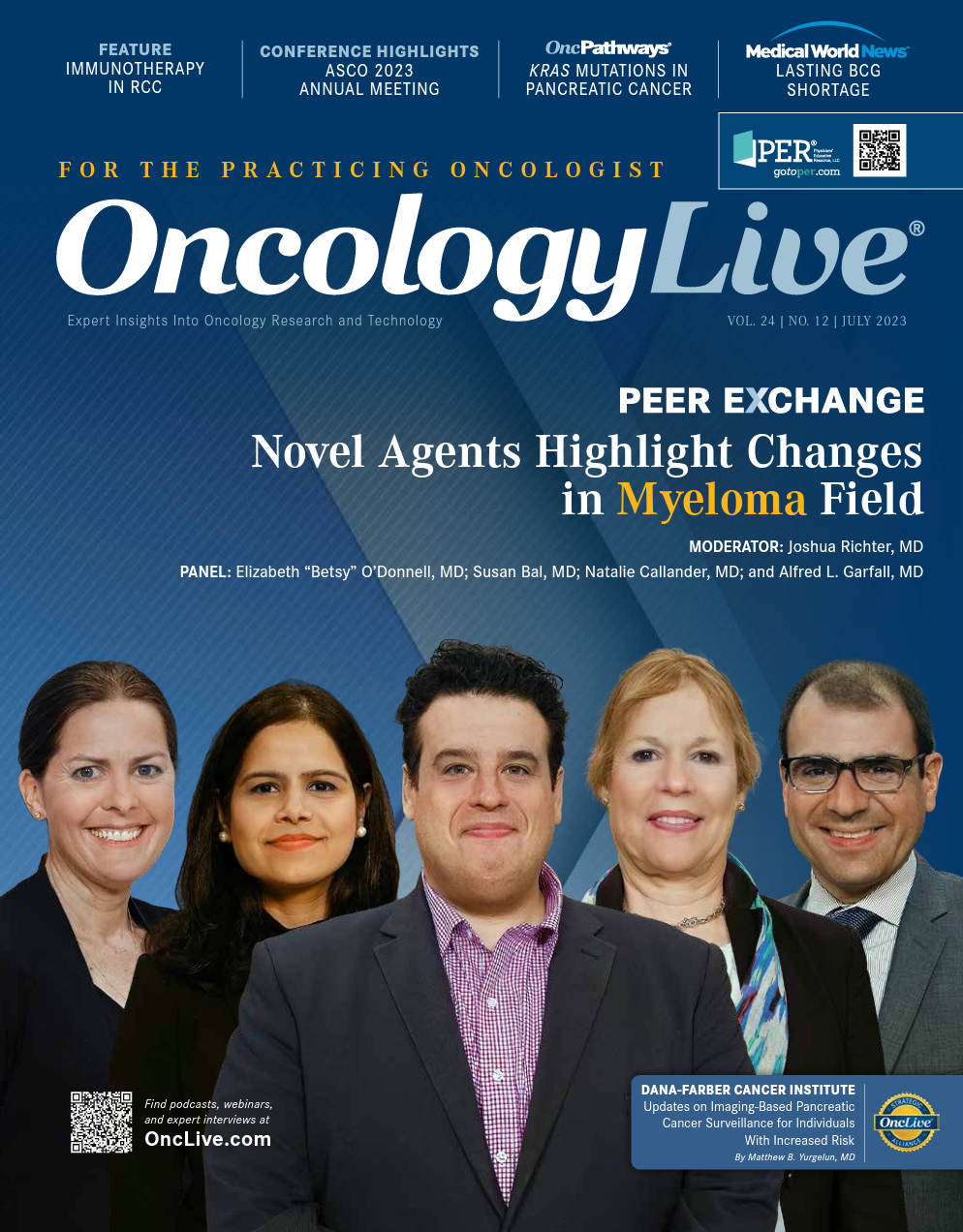Publication
Article
PROSPECT Trial Looks to Add Effective Option for Patients With R/R PCNSL
Author(s):
Efforts to develop the first FDA-approved agent specifically for patients with primary central nervous system lymphoma have been initiated with the phase 2 PROSPECT trial.
Lakshmi Nayak, MD

Efforts to develop the first FDA-approved agent specifically for patients with primary central nervous system lymphoma (PCNSL) have been initiated with the phase 2 PROSPECT trial (NCT04947319).1
“PCNSL is an extremely rare disease; it accounts for [approximately] 3% to 4% of malignant central nervous system [CNS] tumors,” Lakshmi Nayak, MD, the director of the Center for Central Nervous System (CNS) Lymphoma, a senior physician at Dana-Farber Cancer Institute, and an assistant professor of neurology at Harvard Medical School, in Boston, Massachusetts, said in an interview with OncologyLive. “The diagnosis is typically made when patients present with neurologic symptoms and an MRI [of the] brain or is performed. There are certain characteristics that are suggestive of primary CNS lymphoma or CNS lymphomas in general in the brain; however, we always recommend histopathologic confirmation to make the diagnosis. In general, this is a disease of older people; the median age of diagnosis is [approximately] 65 years.”
PCNSL is a highly aggressive form of extranodal non-Hodgkin lymphoma that is typically confined to the brain, eyes, and cerebrospinal fluid, and does not usually display evidence of systemic spread. A favorable response to both chemotherapy and radiotherapy is typical, but survival is still inferior compared with lymphomas occurring outside of the CNS. Additionally, if a patient fails frontline therapy, the prognosis is poor.2
PROSPECT will evaluate the second-generation Bruton tyrosine kinase (BTK) inhibitor tirabrutinib (formerly ONO-4059) in patients with PCNSL. Tirabrutinib is a selective agent that can be given orally once daily and has previously displayed clinical activity in patients with relapsed or refractory B-cell malignancies. The agent binds irreversibly and covalently to BTK Cys-481, with significantly greater selectivity for EGFR, ITK, and BMX compared with the first-generation BTK inhibitor ibrutinib (Imbruvica).3
The FDA granted tirabrutinib orphan drug designation on March 21, 2023, for the treatment of patients with PCNSL. Outside the United States, the agent has received approval for relapsed or refractory PCNSL in Japan, South Korea, and Taiwan, in March 2020, November 2021, and February 2022, respectively.4
Tirabrutinib has previously shown efficacy as monotherapy for patients with relapsed or refractory PCNSL in a Japanese phase 1/2 trial (JapicCTI-173646). The study enrolled patients 20 years or older with a cerebral lesion over 1 cm in the longest diameter identified via gadolinium-enhanced nuclear MRI within 2 weeks of the first dose of tirabrutinib. Patients also needed to have a life expectancy of at least 3 months and a Karnofsky performance status (KPS) of 70 to 100 to be eligible for enrollment. Patients without a B-cell neoplasm, those who received a corticosteroid within 14 days prior to the first dose of tirabrutinib, and those with infectious diseases were excluded.
In phase 1, oral tirabrutinib evaluated during a dose-limiting toxicity (DLT) period of 28 days. The agent was administered at a dose of 320 mg daily in cohort 1 and 480 mg daily in cohort 2. In phase 2, the agent was given at the dose determined in phase 1 for 1 cycle.5
The primary efficacy end point was overall response rate (ORR) assessed by central independent review committee (IRC). Adverse effects (AEs), complete response (CR) rate, best overall response (BOR), duration of response (DOR), progression-free survival (PFS), and overall survival (OS) were all also assessed.5
At the June 13, 2019, data cutoff, 20 patients were treated with tirabrutinib 320 mg and 24 patients with tirabrutinib 480 mg. The median age of all enrolled patients was 60 years (range, 29-86) and the median KPS was 80 (range, 70-100). Most patients were men (54.5%), had relapsed disease (75.0%), had undergone whole-brain radiotherapy (65.9%), and had had previous treatment with rituximab (Rituxan; 59.1%). All patients had previously received high-dose methotrexate and the median number of prior therapies for PCNSL was 2 (range, 1-14).5
Findings from the phase 1 portion of the study showed that the ORR by central IRC was 63.6% (95% CI, 47.8%-77.6%), including a CR rate of 34.1% (95% CI, 20.5%-49.9%), among all patients (N = 44). The median PFS was 2.9 months (95% CI, 1.8-11.1).5 More specifically, patients treated at the 320-mg dose level achieved an ORR of 60.0% (95% CI, 36.1%-80.9%), with a CR rate of 25.0% (95% CI, 8.7%-49.1%). The median PFS was 2.1 months (95% CI, 1.8-not estimable [NE]).5
Notably, patients who received the 480-mg dose (n = 7) experienced an ORR of 100% (95%, 59.0%-100%), including a 57.1% (95% CI, 18.4%-90.1%) CR rate and a median PFS of 11.1 months (95% CI, 1.4-NE). Among those treated at this dose on an empty stomach (n = 17), the ORR was 52.9% (95% CI, 27.8%-77.0%), the CR rate was 35.3% (95% CI, 14.2%-61.7%), and the median PFS was 5.8 months (95% CI, 1.0-5.8).5
“The response rate was very profound,” Nayak said. “[According to] long-term data, it seems that there’s a reasonable [number] of patients that tend to have long-term remission. Of course, we need longer follow-up and we’re waiting to see how the drug performs in our population.” Safety data revealed that any-grade AEs occurred at a rate of 58.8% in the overall population, with 47.7% being of grade 3 or greater severity. The most common any-grade AEs were rash (31.8%), neutropenia (22.7%), leukopenia (18.2%), and lymphopenia (15.9%). Commonly reported grade 3 or higher AEs were neutropenia (9.1%), lymphopenia (6.8%), leukopenia (6.8%), and erythema multiforme (6.8%).5
Serious AEs occurred 13 times in 9 patients, including 8 adverse drug reactions in 6 patients. Treatment with tirabrutinib was discontinued because of AEs in 3 patients. One death attributed to an AE was reported.5
“We expected an AE profile that would be slightly different and better than the first-generation [BTK inhibitors],” Nayak said. “[We saw] a fair number of patients that experience rashes—that seems to be the most common AE—[and] the majority of these rashes can be managed. Patients [also] developed neutropenia with a risk for infections. The risk is there, but the high-risk infections are uncommon with this drug. They did not see cardiac toxicities. One of the concerns with BTK inhibitors is the possibility of its effect on developing cardiac arrhythmias, the most common [being] atrial fibrillation.”
No DLTs were reported in phase 1 and the maximum-tolerated dose was not reached. Thus, the recommended phase 2 dose was 480 mg. However, the dose for phase 2 was reduced to 320 mg because of the presence of 3 grade 3 skin-related AEs and the only death—which was attributed to pneumocystis jirovecii pneumonia and interstitial lung disease—were observed at the 480-mg dose level. However, investigators added that 2 other clinical studies showed treatment with tirabrutinib to be safe and tolerable at a dose of 480 mg under fasted conditions.5
Details of the PROSPECT Trial
PROSPECT is a nonrandomized, parallel assignment trial that will evaluate the efficacy, safety, and pharmacokinetics of tirabrutinib monotherapy for adult patients with relapsed or refractory PCNSL in part A. In part B of the study, tirabrutinib will be examined in combination with methotrexate/ temozolomide/rituximab or rituximab/methotrexate/procarbazine/ vincristine for the treatment of adult patients with newly diagnosed treatment-naïve PCNSL.
In part A, patients will receive oral tirabrutinib at 480 mg once daily on an empty stomach until disease progression or unacceptable toxicity. Part B will evaluate oral tirabrutinib at a dose of 320 mg or 480 mg in combination with an induction regimen of either methotrexate/ temozolomide/rituximab or rituximab/ methotrexate/procarbazine/vincristine. Induction regimens will continue for four 28-day cycles or until disease progression or unacceptable toxicity.1
To be eligible for either part A or part B, patents must have an ECOG performance status of 2 or less, a measurable brain lesion with a minimum diameter of over 1 cm, and adequate bone marrow, renal, and hepatic function. A life expectancy of at least 3 months is mandatory in the monotherapy arm and at least 6 months is required in the combination arms. Patients with intraocular PCNSL without a brain lesion, those with non–B-cell PCNSL, and those who have undergone prior treatment with a BTK inhibitor will not be eligible for the study.1
The primary end point in part A of the PROSPECT trial is ORR. In part B, the coprimary end points are AEs, CR rate, and estimating the dose of tirabrutinib in combination with each backbone induction regimen based upon AEs, serious AEs, and toxicities reported during the initial cycle of induction therapy in the dose-ranging phase. Secondary end points include DOR, time to response, and best overall response. The study is recruiting patients, with a target enrollment of approximately 112 participants, and is estimated to be completed in July 2026.1
“[PCNSL] is a rare disease, but it’s very treatable,” Nayak said. “Having said that, there is tremendous amount of work that [still] needs to be done. The number of clinical trials that are currently available for [patients with] PCNSL in the past few years has increased tremendously. Options remain, [but] we need to solidify our upfront regimen so that we can get to a cure, which I believe is possible in this disease with the right treatments.”








